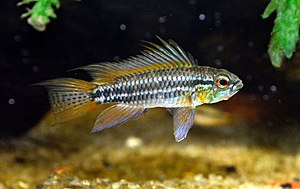Two-lined dwarf cichlid
| Two-lined dwarf cichlid | ||||||||||||
|---|---|---|---|---|---|---|---|---|---|---|---|---|

Two-lined dwarf cichlid ( Apistogramma bitaeniata ) |
||||||||||||
| Systematics | ||||||||||||
|
||||||||||||
| Scientific name | ||||||||||||
| Apistogramma bitaeniata | ||||||||||||
| ( Pellegrin , 1936) |
The two-lined dwarf cichlid ( Apistogramma bitaeniata ) is a cichlid from the South American subfamily Cichlinae and belongs to the genus Apistogramma . The species was first described by the French ichthyologist Jacques Pellegrin in 1936. The specific epithet "bitaeniata" is derived from Latin ("bi" = "two"; "taeniatus" = "banded").
features
While males grow up to 8 cm long, the females stay up to 5 cm smaller. Apistogramma bitaeniata occurs in the color variants blue, yellow and occasionally also red as well as in mixed forms of these variants. The animals usually have two more or less pronounced, dark longitudinal stripes on a light background. Males have a speckled, conspicuously two-pronged caudal fin (caudal). Females are less conspicuously colored than males and their finnings are less intense, the caudal is trimmed. During the reproductive phase the female takes on a lemon yellow color.
Reproduction
The female attaches 40 to 60 eggs to the ceiling of a brood cavity, which are fertilized by a male by adding sperm. The larvae hatch after about 4 days and swim freely after another 5 to 6 days. Breeding attempts in the aquarium hobby are often successful.
Breeding behavior
The male defends the breeding area, but is not tolerated in the immediate vicinity of the brood. Direct brood care is taken over by the female alone, who aggressively defends the spawn and larvae. The free-swimming larvae are based on the color and behavior of the mother. Rapid head movements or rapid swimming are z. B. a signal of danger, whereupon the larvae freeze and sink to the ground. When breeding in aquariums, one can observe how female conspecifics without offspring imitate a mother's coloration and try to force her larva swarm away from the mother.
food
Basically, the two-lined dwarf cichlid eats omnivorous (omnivorous), but animal food is preferred.
distribution
The distribution area of the species extends from the Brazilian Rio Tefé / Lago Tefé up the Amazon to the region around the Peruvian city of Iquitos . The two-lined dwarf cichlid is also found in the Napo and Yavari rivers . It lives in mixed and black water and can be found in shallow places. The water of its biotopes is very soft (<1 ° dH ) and slightly acidic, the pH value is just below the neutral mark 7.
Synonyms
- Apistogramma pertense var. Bitaeniata
- Apistogramma sweglesi Meineken , 1961
- Apistogramma klausewitzi Meineken , 1962
- Apistogramma kleei Meineken
Individual evidence
- ↑ Bull. Soc. nation. Acclim. Prot. Nat. 83, pp. 56-58.
- ↑ Fishbase: Reproduction of Apistogramma bitaeniata
literature
- Mayland, Bork: dwarf cichlids - South America. Geophagines and crenicarines. Landbuch Verlag, Hanover 1997, ISBN 3784205429 .